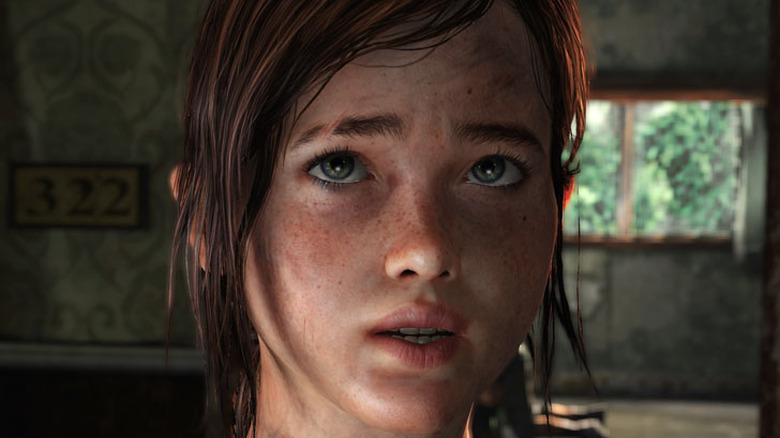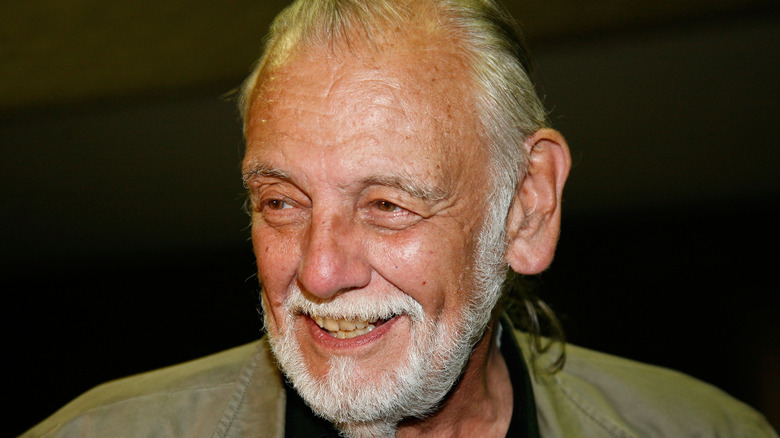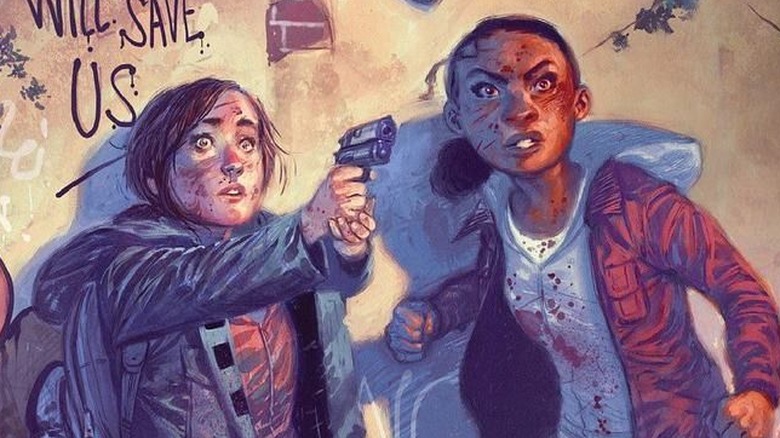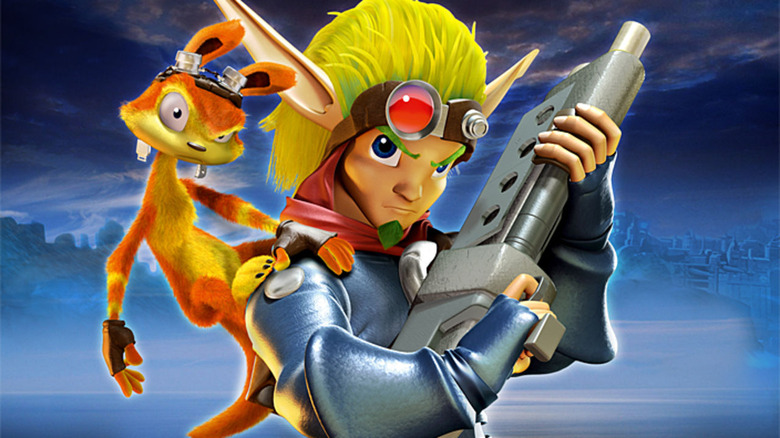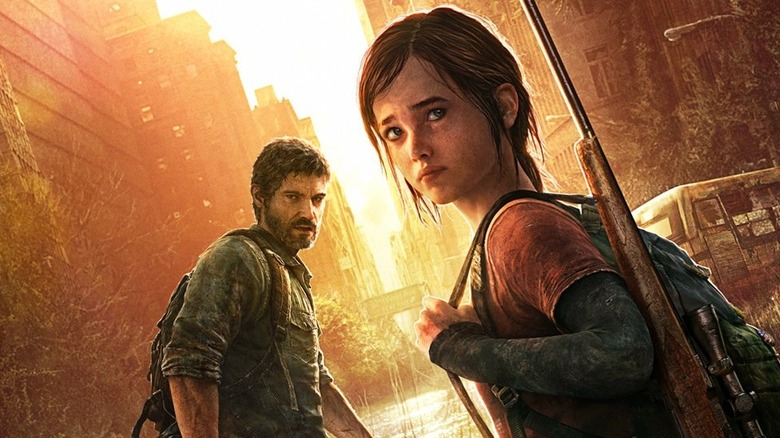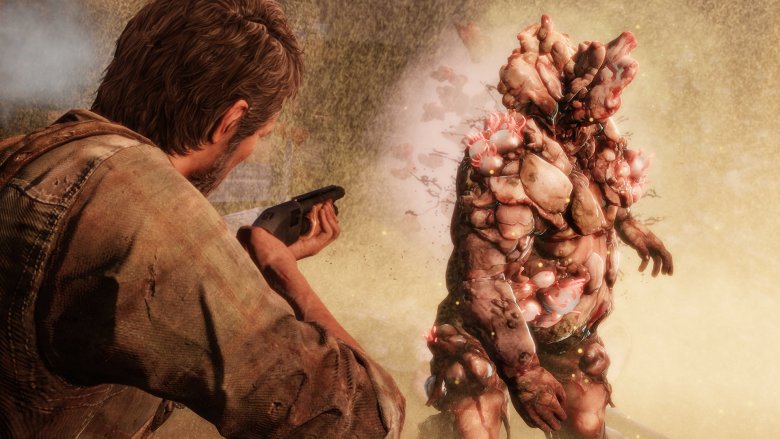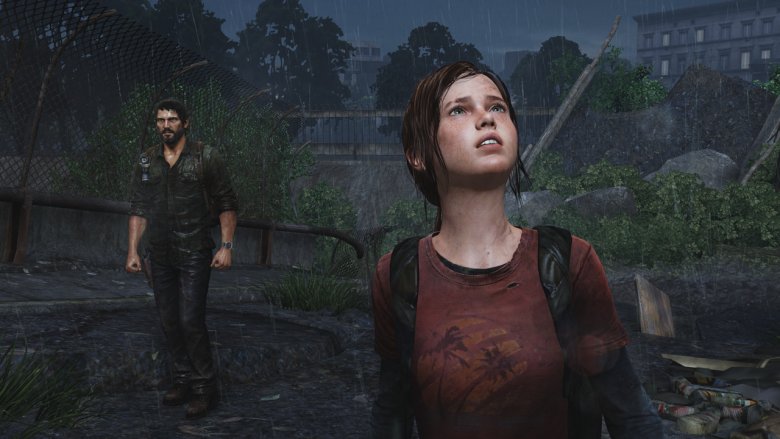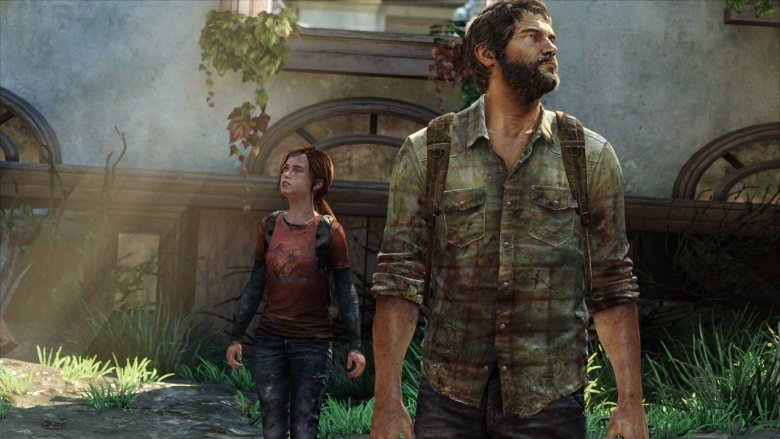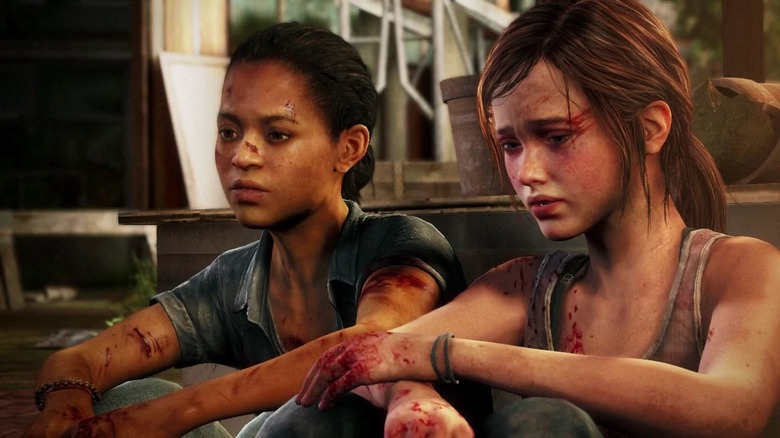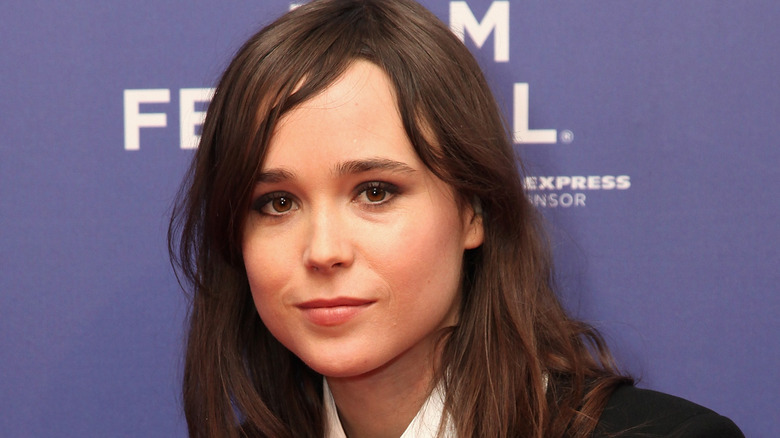The Untold Truth Of The Last Of Us
In an industry filled with sequels, reboots, and remasters, The Last of Us is a rare breed. Not only was the 2013 PlayStation exclusive a new intellectual property, but it became a classic the second it hit stores. There weren't any rough spots or growing pains. The Last of Us' post-apocalyptic world, in which the "infected" have forced humanity to scrounge for scraps just to survive, arrived fully formed, while the game's two leads — Ellie, a not-so-regular teenager played by Ashley Johnson, and her jaded protector, Troy Baker's Joel — became instant stars.
Of course, we'd expect no less from Neil Druckmann, Bruce Straley, and the rest of the Naughty Dog team. After all, these are the same people who brought us classics like Jak and Daxter and Uncharted. They know what they're doing. Still, development on The Last of Us wasn't always easy, and the game wasn't exactly free of controversy post-launch. After all, making video games is really, really hard. Naughty Dog just makes it look easy.
From phone numbers that accidentally worked to Elliot Page's beef with Ellie, here's everything you didn't know about The Last of Us.
Zombie master George Romero says thanks but no thanks
Technically, The Last of Us' "infected" aren't zombies, but anyone who's played the game knows that it owes more than a little to George Romero, the man who wrote and directed Night of the Living Dead and more or less created the modern zombie genre single-handedly. When Romero was presented with the idea that eventually became The Last of Us, however, he passed.
Back in 2004, The Last of Us creator Neil Druckmann attended Carnegie Mellon University, where he was working on a master's degree in entertainment technology. As part of a class project, Druckmann had to develop a video game pitch based on The Night of the Living Dead. Druckmann's professor, a friend of Romero's, then ran those by the esteemed director. Romero chose one project as the winner.
Druckmann came up with a game that mixed Ico with zombies and Sin City, in which a police officer has to protect a young girl from the undead hordes while also battling a heart condition. Somewhere along the way, the cop dies and the girl becomes the lead character. Romero gave another project his seal of approval. Maybe he made the wrong choice. Almost a decade later, that idea transformed into The Last of Us, which netted Druckmann and Naughty Dog hundreds of awards. Romero clearly knew zombies, but his taste in video games might've been a little lacking.
From comics to PlayStations and back again (and again)
Neil Druckmann didn't always want to be a game designer. Originally, he wanted to make comics. In fact, before The Last of Us became a Naughty Dog project, Druckmann took his failed Night of the Living Dead concept and retooled it into a comic book called The Tuning, which he planned to draw in his spare time. Unfortunately, Image Comics "liked it but didn't love it," and Druckmann shelved the series.
Druckmann's comic-writing dreams did come true eventually, though. With co-writer and artist Faith Erin Hicks, the cartoonist responsible for Friends With Boys and Demonology 101, Druckmann produced The Last of Us: American Dreams, a four issue miniseries that serves as a prequel to the game. The book, published by Dark Horse Comics, is a fundamental part of The Last of Us' story and directly contributed to the game's plot. Riley, Ellie's best friend, started as a character in the comic. Druckmann liked Riley so much that he added a mention of her to the game after the fact and later made her the co-star of the game's DLC, The Last of Us: Left Behind. Appropriately, Hicks got a shout out in The Last of Us' end credits for her contributions to The Last of Us' lore.
That's not all. As anyone who's played The Last of Us knows, the game also has a pretty obvious tribute to its comic roots: players can collect comic books hidden around The Last of Us' post-apocalyptic landscape.
The tale of Joel and Daxter
The Last of Us could've been different — really, really different. In the '90s and early '00s, The Last of Us' developer, Naughty Dog, was best known 3D platformers like the original PlayStation's flagship title, Crash Bandicoot, and the critically acclaimed PlayStation 2 series Jak and Daxter. While Naughty Dog is now most famous for Uncharted, those franchises are still big with fans, and in 2009 the studio decided to devote resources to a big Jak and Daxter reboot — only to shift gears and make The Last of Us instead.
Following Uncharted 2's success, Naughty Dog split its staff into two groups for the very first time. One team was devoted to the Uncharted franchise, while the other, which included both Neil Druckmann and Uncharted 2 director Bruce Straley, was tasked with bringing Jak and Daxter into the modern age. At 2013's International Game Developers Association conference, Druckmann shared some concept art for the proposed reboot, which abandons Jak and Daxter's cartoony designs for something much more realistic.
Ultimately, however, Naughty Dog's second team realized that they didn't want to make Jak and Daxter. "The idea we were passionate about were kind of getting away from what Jak and Daxter was," Druckmann explains. Eventually, the developers realized that they were just using the Jak and Daxter name for marketing purposes, and asked Naughty Dog's higher ups if they could do something else. The execs agreed, and the team started brainstorming ideas — and thus, The Last of Us was born.
Taking a stand against game industry sexism
You'll spend most of The Last of Us controlling Joel, a middle-aged smuggler, but his teenage charge Ellie is just as important to the story. However, that didn't stop executives from trying to minimize her role in The Last of Us' marketing campaign.
Before the game launched, Ashley Johnson, who brought Ellie to life via a combination of voice action and motion capture, talked with VG247 about "the feeling, generally, that... games won't sell as well with a woman on the cover." In the same interview, Druckmann admitted that he'd been pressured to "push Ellie to the back" of The Last of Us' box art. He and everyone else at Naughty Dog "flat-out refused" to comply, and put her front and center instead.
That wasn't The Last of Us' only battle with sexism, either. Early in development, the fungal plague that transforms humans into monsters was only going to affect women. Druckmann and his team soon realized that a game based on gunning down women would've been grotesquely misogynist and backed off on the idea. More recently, critics lambasted The Last of Us Part II's gruesome first trailer for its depiction of intense, seemingly unmotivated violence against women. Hopefully, the full game is a little more nuanced. We'll see.
For a good time, call ...
Here's the thing about hardcore fans: they notice everything. If you put a phone number in your game, for example, they're going to see who answers — and if they're playing The Last of Us, they're going to get a much saucier reply than they bargained for.
The Last of Us' detailed environments are filled with small details that don't really progress the plot, but do add lots of texture to the game's monster-infested world. Shortly after The Last of Us came out, for example, fans noticed that a flyer in the game promoting pest control services contained two full phone numbers. It turns out that those numbers not only led to real, working phone lines, but that they promoted premium phone sex services. One of Kotaku's writers even recorded one of the messages, if you want to take a listen (but use headphones — these numbers are definitely not safe for work).
As Druckmann explained to Kotaku, the sexy phone numbers weren't put in the game as some kind of Easter egg. They're just mistakes. One of The Last of Us' artists assumed that changing the prefix on phone numbers to 555 makes them invalid — that's "what they do in movies," Druckmann points out — but the rules are apparently different for 1-800 lines. At any rate, a patch quickly removed the numbers from the game, making The Last of Us safe for kids all over the world yet again — provided that they can cope with the game's horrific and brutal violence, of course.
A real-life plague (kind of)
The Last of Us, which deals with a world where fungus morphs regular human beings into monsters, is science fiction, but it's very, very close to science fact. The fungus itself, for example, is a real, honest-to-goodness thing. It just doesn't affect humans — not yet, anyway.
Cordiceps unilateralis (which scientists now call ophiocordyceps unilateralis), the in-game predator that transforms men and women into predatory beasties, is well-known among scientists and horror fans as the substance that makes actual, real-life zombies. Ophiocordyceps unilateralis reproduces by infecting ants, taking control of their nervous systems, forcing them to climb plants and latch onto stems and leaves, and then slowly replacing their flesh with spores until there's nothing of the original creature left.
It's utterly horrific, making it a perfect fit for The Last of Us' dismal world. The Last of Us' design team first learned about the cordiceps fungus while watching an episode of the BBC nature documentary Planet Earth. By all accounts, they were entranced immediately. "Right away the idea popped in our head of like, 'What if it jumped to humans?'" Druckmann tells NPR. Scientists say that such a leap isn't likely in the real world, but it works great for The Last of Us — at the very least, fungus creatures are a lot more interesting than the traditional zombies that we've seen pop up in games again and again and again (and again).
The Last of Us, now with a happier ending!
The Last of Us' ending is one for the ages. Nearly five years after the game's debut, people are still debating whether or not Joel made the right choice by saving Ellie (and possibly dooming humankind to extinction in the process).
It could've been different. In fact, at one point, Joel and Ellie got a relatively happy ending. In an interview with Game Informer (shared online by Videogamer), Druckmann shared some of the ways that The Last of Us' conclusion changed throughout the development process. Originally, Ellie was going to be a much more innocent character, and the big end-game twist involved the teenage girl taking a life for the first time. That didn't pan out, however, as it made Ellie passive during The Last of Us' many combat scenes, lessening players' attachment to the character.
Even once Naughty Dog decided on the current direction, the specifics weren't clear. At one point, Joel and Ellie were destined to settle down in San Francisco, where they'd help other survivors rebuild society. Druckmann decided that giving Joel and Ellie a hopeful ending was "letting them off a little too easy" and changed it. The new, final ending is thematically appropriate, but it wasn't necessarily popular — according to Druckmann, it tested poorly with audiences, and split the development team in two. He and Straley kept it anyway.
An apocalypse full of Easter eggs
Between Crash Bandicoot, Jak and Daxter, and Uncharted, Naughty Dog has a ton of classic video game franchises in their stable, and as it turns out, some of them survived the end of the world. The Last of Us is crammed full of references to old Naughty Dog games. You just have to know where to look.
For example, when Ellie learns how to whistle, she starts with a rendition of the Uncharted theme. A bar in Pittsburgh is named O'Sullivan's Pub in tribute to Nathan Drake's long-suffering sidekick, Victor Sullivan, and looks a lot like the pub that plays a key role in Uncharted 3: Drake's Deception. In The Last of Us' post-apocalyptic future, that Uncharted feature film finally escaped development hell and made it to theaters, too. In fact, according to an old newspaper, there have been 13 installments in Uncharted's big-screen franchise, with none other than Justin Bieber playing the lead role.
Those are just the Easter eggs referencing Uncharted. In a toy store, you can find both Uncharted and Jak and Daxter board games. Jak and Daxter plushies hang out in one of the characters' bedrooms. All that, and that's just the tip of the iceberg. Clearly, Naughty Dog's games were even more popular in The Last of Us' world than in ours, and you could spend hours, if not days, trying to hunt down all of the Easter eggs, references, and tributes to the company's previous titles.
That controversial kiss isn't as mysterious as you thought
The Last of Us doesn't spend a lot of time delving into Ellie's sexual identity. She and Joel are too busy trying to survive. The Last of Us' award-winning downloadable content pack, The Last of Us: Left Behind, is a different story. In the brief adventure, which takes place largely before the main game, Ellie spends a day in an abandoned shopping mall with her best bud, Riley. But Riley is more than just a friend: late in the episode, Ellie kisses Riley goodbye. When Ellie apologizes, Riley just smiles. "For what?" she asks.
Immediately, the fan community went into overdrive. Does that kiss mean that Ellie a lesbian, or is the short smooch simply a tender moment between two friends? According to both Neil Druckmann and Ashley Johnson, it's not much of a question. "When I was writing it I was writing it with the idea that Ellie is gay," Druckmann told GayGamer, "and when the actresses were working they were definitely working with the idea that they're both attracted to each other." Johnson agrees. "That completely makes sense for who Ellie is and why her relationship with Riley was so important to her," she tells Destructoid.
Riley was already an established character from the comics when Naughty Dog began working on Left Behind, and as Druckmann says, transforming her into Ellie's love interest wasn't a political statement. It just made sense. Debate all you want, folks, but there's a definite answer here. Ellie is gay. It's not ambiguous at all.
Elliot Page is not a fan, and with good reason
Judging by the review scores and general internet chatter, almost everyone loves The Last of Us. But don't count Juno and Inception star Elliot Page among the game's fans. When asked about the resemblance between Page and The Last of Us' Ellie, the actor accused Naughty Dog of stealing his likeness. That's a big accusation, especially since Page starred in an entirely different game that launched around the same time.
It's not just that Ellie and Page have essentially the same first name. When The Last of Us' first trailer debuted in 2011, fans noticed the similarity between the two almost immediately. Page noticed, too. During a Reddit Ask Me Anything session, a fan asked Page what he thought about the virtual doppelganger. "I guess I should be flattered that they ripped off my likeness," Page replied, "but I am actually acting in a video game called Beyond: Two Souls, so it was not appreciated."
Of course, Page ended up having his own problems with Beyond: Two Souls. Hackers discovered a naked model of Page's character, violating the no-nudity clause in his contract, and Page threatened to sue. At least Page doesn't hold a grudge against Ellie actor Ashley Johnson. When a fan reached out to Page on Twitter and complimented his performance in The Last of Us, Page directed them to Johnson, encouraging fans to "send her the props!!"

